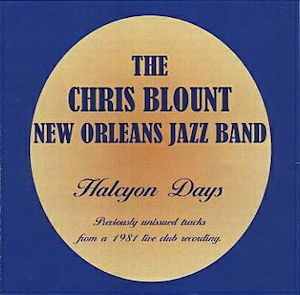
BUY NOW AmazonUK AmazonUS |
THE CHRIS BLOUNT NEW ORLEANS JAZZ BAND Halcyon Days
|
1. Hindustan
2. My Old Kentucky Home
3. Corrine, Corrina
4. Climax Rag
5. Bye and Bye
6. I’m Putting All My Eggs in One Basket
7. Isle of Capri
8. Where He Leads Me
9. I Wonder Who’s Kissing Her Now
10. Don’t Give Up the Ship
11. See See Rider
12. Running Wild
13. I’m Alone Because I Love You
14. Bluebells Goodbye.
Baz Hodgkinson – Trumpet, vocal (tracks 3 and 6)
Chris Blount – Clarinet
Dave Vickers, trombone, vocal – Trombone (tracks 5 and 12)
Pete Trevor – Piano
Dave Brennan – Banjo
Harry Slater – Double bass
Mick Ellis – Drums
Recorded live at The Bell Inn, Derby, ca. spring 1981.
For fans of traditional jazz, particularly of the New Orleans variety, 1998 did not end on a good note as a week before Christmas Chris Blount died unexpectedly on Dec. 18th. A devotee of the New Orleans style, he had led his jazz band for over three decades and was well known in Britain and Europe from the many tours on which he and the band had undertaken.
It has often been remarked that Blount was a disciple of George Lewis, and not only of Lewis’ clarinet style but the Lewis band’s style. While all of the tracks on this CD give some evidence of such influences, the first track, Hindustan, exemplifies these clearly, particularly the emphasis on collective improvisation. Hodgkinson lays down a clean lead on trumpet and doesn’t stray far from it in the rest of the track. One is always reminded of the melody in the ensembles even when it is not specifically delineated, and Hodgkinson never overblows. He uses vibrato sparsely and has a tone which embraces the listener.
With a certain fluidity, Blount weaves his way around what Hodgkinson is laying down, a touch of vibrato here and there, deftly working through the registers with Lewis-like flourishes and runs. His tone is not harsh but warm and woody. Behind and below them is Vickers’ trombone, sometimes sliding (and on blues tracks, particularly, delivering rich glissandi) sometimes spitting out staccato notes, and like Hodgkinson using little vibrato. On banjo Brennan plays a solid four in each measure, never rushing, always right there. He keeps the designated tempo, which is nigh perfect for each tune. (As Bill Dickens says in his liner notes, New Orleans bands “excel at … playing tunes at the correct tempo,” and this CD is exemplary in this respect. Blount sets the tempi and Brennan maintains them.)
The rest of the rhythm section does not fare as well as it might, the balance lacking somewhat so that we don’t hear much of Slater on string bass, but we do hear the bass drum, which tends to pound out four beats per measure. However, Ellis does insert nice accents on the snare (and tom tom elsewhere) from time to time. Trevor’s piano is mainly in the background except where he is given a solo, as he is on this first track. Other solos on other tracks are taken by Blount and Vickers, that by Blount coming invariably first and that by Vickers immediately following the piano solo. All of the other choruses are ensemble, and they all show pleasing variety—no repeating licks between choruses. Each chorus is, indeed, a musical conversation among the players. While Hindustan is over six-and-a-half minutes long, it seems to be much less, the coda coming all too soon.
As I said above, these traits are to be seen in just about every track. Overall, solos are relatively few, usually only two or three in a track, these most often being by Blount, Vickers, and Trevor, often in that sequence. Brennan is given one on Don’t Give Up the Ship and Hodgkinson one on Running Wild, but Slater and Ellis are passed over in this regard. All of the other choruses are taken by the ensemble, and wonderfully entertaining they are. While it is interesting to hear a competent soloist’s improvisation on a tune, it is much more exciting to me to hear how the several players complement each other in the collectively improvised choruses. Of such interplay in ensembles this band was a top purveyor.
The tune list for this CD is also varied. There are twelve-bar blues, hymns and spirituals, a march, a rag, and pop songs, all selected from the Blount band’s “book”—just as the bands of New Orleans included such a mélange back in the day when their business cards stated they played “music for all occasions” (as many still do today). Vocals are not excessive in number, one being unaccredited anywhere, namely that on I’m Putting All My Eggs in One Basket (track six) which, if my ears do not deceive me, is by Baz Hodgkinson. I am, however, a bit puzzled by the applause that concludes each track. It sounds a bit like canned applause, and yet there would be no need for that as this was a live performance. Perhaps it is due to the microphone(s) placement—there are also a couple of places where there seems to be a slight shifting of the microphone, perhaps to accommodate a vocal since these tend to be a bit “off-mike.” But these are all minor “flaws.”
This CD is a welcome addition to the Blount Band’s discography, marking as it does the 20th anniversary of Chris Blount’s passing. Perhaps other recordings will surface in the near future and be released, which Blount aficionados and the rest of the traditional jazz community would certainly receive with relish. Undoubtedly this CD will—and should—get such a reception.
PKCD-415 is available from p.e.k. SOUND at www.jazz-at-peksound.co.uk and undoubtedly also at on-line outlets such as Amazon and Upbeat Records.
Bert Thompson